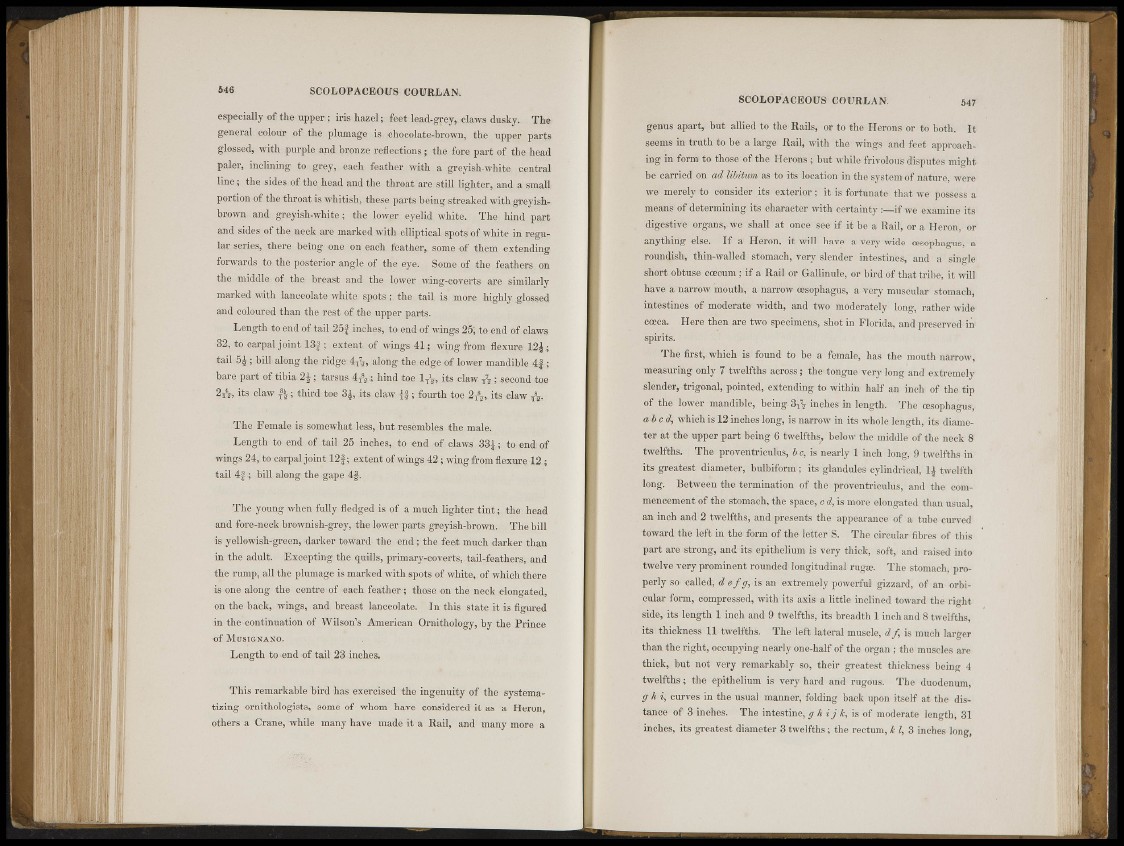
546 SCOLOPAVKOCS COtfRJLAN.
especially of the upper; iris hazi^'itssi leadigrey, claws dusky. The
gern-ri'.l colour of the plumage ng chocsilato-brown. the upper pacts
glassed, with, purple and bronze reflectionsthe fore pari of the head
PlllCT> mi'lining to, grey, each feather with a greyish white, -central
line ; the. sides of the bead and the. throat are «til! lighter, ami a small
portion of the throat is whitish, these parts being' streaked with greyishbEOWB
ami gri-yisli-whitiy the loner eyelid White, The bind part
and sides of the neck are marked with elliptical spots of white img|g$t>
lar series, there being one on cucli, )Vatlior, some pf them extolling
forwards to the posterior angle of th^ye. Some of the feathers on
the middle, of the breast and tlio lower wing-weft» are similarly
marked with la,g®jijsia,te white. spots : the; tail ;is. iiior<'..;:higbly .glossed
and iMilouivd than thara-it «f the upper parts.
Length to end of tail 25J inches, tiumd m wings 25; to. end of flaws
3% to carpal joint 1.'!; ; extent of wings, 41?; wing from flexure 1&|;
tail Bi ; bill along the rid^life !alojl|4^eige of loafer(mandible
bare part of tibia '21; tarsus 4As; hind toe 1 its cltm -ft; soooml lue
St4}, its claw ^ j third toe % tf| claw } fourth te&Sjg its claw
The Female is somewhat less, but resembles, the male.
I.imgth to end of tail 25 inches, to «id of daws' .33J.;. to end of
wings 21, to carpal joint 12|;. extent.®! wings 42; wing from flesjme.12.;
tail 41; bill aieng the «jape 4f,
The. young »hen fully fledged is of a much lighter tint; the• head
and fce-.neek biiowmisht.grey, the lower parts greyish-brown. The bill
is velumish-green, darker tcnvarcl the «rid:; the feet much darker than
in the adult. Excepting the quills, priruary-craverts, tail- feathers,. and
the rump, «lithe plumage is marked,with spots of white, of which there
-is-one along the centre-of-each feather ; thase <on the neck siaagated,
on the back, wings, and breast, Ifceeoijffe In this state it/is figured
in the-continuation of Wilson's American Ornithology, by the Prince
Of AtCJSlfiNAXO, - • .. .. i .
^-¡Length to vend of tail 23 inches.
This remarkable 'bird 'has exercised the ingenuity of the systematizing
ornithologists,' some of whom hare considered it as a Heron,
others a Crane, while many have made it a Rail, amd many more a
SCOLOPACKOUS GOÏTRLAN. 547
genus apart,, but allied to thé'Hails, oi to the Herons or to both. It
seems to truth to bé .a large Rail, with the wings and feet approaching
in form to tSiose of the Herons ; but while frivolous disputes might
be* carried on ad libitum as to its location hi the system of nature, were
we' merely |B< consider exterior ; it is fortunate that we possess a
means of determining its character with certainty :—if we examine its
digestive organs,, we shall at oncë see if it be a Rail, o r a Heron, or
anything else. If a Heron, ii will have a veiy wide cesophagus, a
roundish, thin-walled stomach, very slender intestines, and a single
short obtuse eoeoum ; if a. Rail or Gallinule, or bird of that tribe it will
have a narrow mouth, a narrow oesophagus, a very muscular stomach,
intestines of moderate width, and two' moderately long, rather wide
cueca. Here them are two specimens, shot in Florida, and preserved in
spirits.
The first, which is found to be a female, has the mouth narrow,
measuring only f twelfths across ; the- tongue very long and extremely
slender, trigonal, pointed, extending to within half an inch of the tip
of the lower mandible, being. i!y3 inches In length. The cesophagus,
abed, which is 12 inches long, is narrow in its whole length, its diameter
at the upper part being' 6 twelfths, belôw the middle of the neck 8
twelfths. Thftproventriculms, be, is nearly 1 inch long, 9 twelfths in
its greatest diameter, bulbiform-; its glandules cylindrical^ twelfth
long. Between the termination of the proventriculus, and the commencement
of the stomach, the space, c d, is more elongated than usual,
an inch and'2 twelfths, and presents the appearance of a tube curved
toward the left in the form of the letter S. The circular fibres of this
part are strong, amd it® epithelium is. very thick, soft, and raised into
twelve very prominent rounded' longitudinal rug» The stomachj properly
so called, d «/g, is. an extremely powerful gizzard, of an orbicular
form, compressed, with its axis a little inclined toward the right
side, its length 1 inch and â twelfths, its breadth 1 inch and 8 twelfths,
its thickness U twelfths. The left lateral muscle, d f , is much larger
than the right, occupying nearly one-half of the organ ; the muscles are
thièk, but not very remarkably sc^ their greatest thickness being 4
twelfths ; the epithelium is very hard and rugous. The duodenum,
g hi, curves in the usual manner, folding back upon itself at the distancé'
of 3 inches'. The intestine, g h i j k, is of moderate length, 31
inches, its greatest diameter 3 twelfths ; the rectum, i l , 3 inches long,